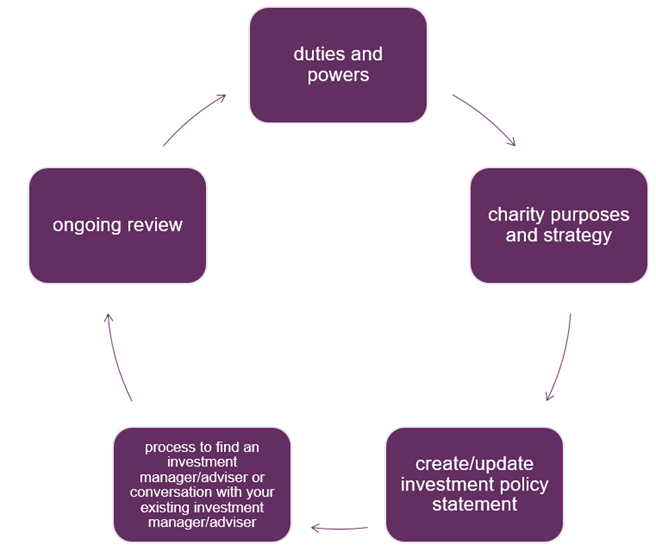7. Implementing your investment policy
Once you have agreed your charity’s investment policy, you’re ready to start investing and this is where professional advice can be key.
Charity trustees need to understand what they are doing with the charity’s money, when it comes to investing. Some charity trustee boards may have the skills and knowledge to manage their own investments. Others will need some professional help and support at various stages of the process.
The type of support that charity trustees may need will depend on:
- the type of assets they are considering investing in
- what their strategy is and
- the complexity of the arrangements that they will be entering into.
If charity trustees are considering seeking professional support, then there are some key points to consider:
- What stage are we at? You may need help thinking through what’s most important to your charity and what your overall strategy should be. Or you may need help developing a strategy or investment policy statement. Many professional advisers and consultants offer help in relation to strategy and policy.
- What kind of assets are we thinking about investing in? Stocks and shares may mean that you turn to an investment manager, financial planner or investment consultant. If your asset is a building, a surveyor or property consultant would be more suitable.
- What returns are we looking for on the investments? If you are seeking non-financial returns, then you might consider support from professionals with a special focus on social investments.
- What support might we need on an ongoing basis? Will you need support to understand how the investments are performing and whether any changes are needed?
Once you have decided what kind of support (if any) you need, the next step is to find the right help. There might be a range of professionals that can help, so you will need to choose the right provider for your charity’s needs.
You might want to invite professionals to give a presentation on the services they can provide or to interview them so you can choose the right service for your charity.

It is a good idea to make a list of your requirements and any questions you have. For example:
- What experience do you have of working with charities like us?
- Which individuals/team would look after our charity and where are they based? Will we be able to contact them if we have questions or concerns about our investments?
- What is your investment proposal for our charity?
- What investment performance could we expect?
- What information will we receive from you, in what format, and when?
- What is the total investment management cost? It is important to understand how much it will cost for the support you want and if the expertise provides value for money.
- What is your approach to ESG and active stewardship?
Once a professional adviser has been chosen by the charity trustees, the arrangement should be formalised so that each party is clear about what is expected and what is to be provided. For example, this could be done in a letter of engagement or investment management agreement.
Investment planning and review cycle

The decisions that charity trustees make about investing the charity’s money are important. These allow the charity to generate financial and non-financial returns for the future and support the charity’s purposes and strategy. However, these decisions are not just made once and then forgotten about – the charity’s approach to investing should be subject to regular review, taking into account changes of circumstances and the environment in which the charity operates.
The charity trustees will want to keep their contract with any professional firm under periodic review. As the charity’s strategy evolves over time, charity trustees need to ensure that its investment policy keeps pace, and that its investments are continuing to support the charity’s goals. Concerns over service or value for money may also prompt a review, for example.

Case studies
The following case studies share examples of how different charities approached their investments.
